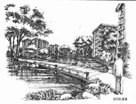| |
A&M-led team's plan wins international
competition
 Ecological plan for 1,250-acre
multi-use community earns Chinese government OK
Ecological plan for 1,250-acre
multi-use community earns Chinese government OK
| |
|
A landscape architecture design team composed of students, former students and faculty from Texas A&M University, placed first in an international competition to design a 1,250-acre research park to be built in Dalian, in northeastern China.
The Dalian Research Park will be a multi-use community built with a strong emphasis on environmental protection, explained Chang-Shang Huang, associate professor in the Department of Landscape Architecture and Urban Planning and leader of the winning design team.
“We had confidence that our approach was unique,” said Huang, whose team began the project in August 2001. “We took an ecological approach and tried to understand what limitations the site provided.”
The competition, staged by the government of Dalian and a private Chinese developer, was an invitation-only international affair with entries solicited from designers and landscape architects in Germany, Italy and China as well as the United States.
“The competition offered Texas A&M an opportunity to earn global recognition while demonstrating environment stewardship,” Huang said. “This will be a demonstration project for other cities in China.”
Ten years ago, the seaport city of Dalian was a community that shared a dismal characteristic with other Chinese cities—pollution. The city’s outlook later took a turn for the better when the government took action against the environmental problems, a move that would soon make Dalian a model for other cities in the country. Dalian Mayor Bo Xilai spearheaded the movement, and eventually transformed the city’s image from that of an industrial and polluted town to a beautiful and modern seaside city.
The Dalian Research Park will be divided into four areas including an industrial component, a research component, a commercial service component and a residential component. With environmental protection being the theme for the district, each area, including the residential component, must have a strong emphasis on protecting the environment. The initial construction phase is due to be completed within five years.
Huang said the Dalian government called a design competition rather than utilizing the more affordable bidding system because of the city’s expressed concern for the environment.
“The plan was a most important one for China,” Huang said. “On the business side, the developer’s only concern is profit. If they are not careful about what they are doing, they will have a short-term profit but have a negative effect on the environment.”
The College of Architecture was considered for the competition because of its previous work on a model retirement community in Dalian.
“Texas A&M, as well as the College of Architecture is still a well kept secret,” Huang said referring to the international design community. “This was one avenue where we could really get our name out and make an impact on the global environment.”
After winning the design competition, the team continued to work with the developers and the city of Dalian in phase two of the project, the design development phase, which the team completed and presented in December 2002. The team began working on the project in August 2001.
“The best award in this profession is that you can make a positive impact on other people’s lives,” Huang said.
| |


 Click images to enlarge.
Click images to enlarge.
|
|
| |
|
|